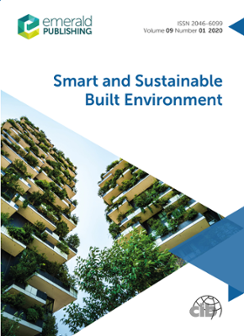Table of contents
A fuzzy synthetic evaluation of the challenges of smart city development in developing countries
Douglas Omoregie Aghimien, Clinton Aigbavboa, David J. Edwards, Abdul-Majeed Mahamadu, Paul Olomolaiye, Hazel Nash, Michael OnyiaThis study presents a fuzzy synthetic evaluation of the challenges of smart city realisation in developing countries, using Nigeria as a case study. By defining and delineating…
Deploying ecosystem services to develop sustainable energy landscapes: a case study from the Netherlands
Paolo Picchi, Simone Verzandvoort, Davide Geneletti, Kees Hendriks, Sven StremkeThe transition to a low carbon future is an emerging challenge and requires the planning and designing of sustainable energy landscapes – landscapes that provide renewable energy…
Barriers to green cities development in developing countries: evidence from Ghana
Caleb Debrah, De-Graft Owusu-Manu, Ernest Kissi, Eric Oduro-Ofori, David John EdwardsOf late, cities across the globe are taking pragmatic steps towards addressing environmental, social and economic problems in the debate on sustainable development. Even so…
Towards sustainable commercial buildings: an analysis of operation and maintenance (O&M) costs in Sri Lanka
Achini Shanika Weerasinghe, Thanuja Ramachandra, James O. B. RotimiRising energy costs and increasing environmental concerns are catalysts for introducing sustainable design features in buildings. Incorporating sustainable design features in…
Assessment of direct evaporative cooler performance with a cooling pad made from banana midrib and ramie fiber
Hery Sonawan, Evi Sofia, Arief RamadhanThe paper aims to apply Buckingham Pi dimensional analysis method for assessing direct evaporative cooler performance with a cooling pad made of banana midrib and ramie fiber. The…
Driving sustainable construction development through post-contract key performance indicators and drivers
Terence Y.M. LamThis research examines what key performance indicators (KPIs) and drivers should be applied at the post-contract phase of construction development to monitor and drive project…
Prioritizing infill structure indicators in a historical context: in terms of economic sustainability- the vicinity zone of Tabriz historic bazaar
Mitra Seyyedpour Esmaeilzadeh, Ahad Nejad Ebrahimi, Vahid VaziriSustainability is one of the major factors in the way of creating new structures in historical contexts. The economic principle plays a very significant role in sustainability…
Sensory and physiological assessment of spatial transient thermal environment changes at a tropical university campus
Nur Dalilah Dahlan, Amirhosein Ghaffarianhoseini, Norhaslina HassanRecent studies have found that the high demand for air-conditioning usage in tropical countries has affected the thermal adaptability of building occupants to hot weather, and…
Exploring applicability, interoperability and integrability of Blockchain-based digital twins for asset life cycle management
Christopher Santi Götz, Patrik Karlsson, Ibrahim YitmenThe blockchain-based digital twin has been recognized as a prominent technological ecosystem featuring synergies with both established and emergent information management…
Potential integration of blockchain technology into smart sustainable city (SSC) developments: a systematic review
Phui Fung Wong, Fah Choy Chia, Mee San Kiu, Eric C.W. LouPrior literature lacks concrete and systematic review of the current blockchain application in smart sustainable city that covered to the full extent of various components. Thus…
The renaissance of augmented reality in construction: history, present status and future directions
Ke Chen, Fan XueAugmented reality (AR) has become one of the most promising technologies in construction since it can seamlessly connect the physical construction environment and virtual…
Ecological houses of Southern Kazakhstan using renewable energy sources
Ardasher Namazbay Yussupov, Akmaral Ardasherovna YussupovaThe purpose of this article discusses the design of underground eco-houses using a dome structure of light construction while taking into account the historical experience of the…
Emissions in different stages of economic development in nations
Amulya Gurtu, Anandajit GoswamiThis paper analyzed country-wise energy consumption, sources of emissions, and how it gets impacted by their socioeconomic development and provides a framework for integrated…
Artificial intelligence-based automatic visual inspection system for built heritage
Lukman E. Mansuri, D.A. PatelHeritage is the latent part of a sustainable built environment. Conservation and preservation of heritage is one of the United Nations' (UN) sustainable development goals. Many…
Barriers for implementing solar energy initiatives in Nigeria: an empirical study
Dahiru Abdullahi, Suresh Renukappa, Subashini Suresh, David OlokeDespite the abundant renewable energy potential in the Nigeria, the power-sector stakeholder has not paid attention to the prospect of the natural resources that can be accrued…
An investigation on the impact of shading devices on energy consumption of commercial buildings in the contexts of subtropical climate
Md. Jewel Rana, Md. Rakibul Hasan, Md. Habibur Rahman SobuzApplication of appropriate shading device strategies in buildings can reduce direct solar heat gain through windows as well as optimize cooling and artificial lighting load. This…
Sustainable strategy to create multisector or unisector smart economic hubs
Mohammed Osama Rasmy, Tarek Abdel Latif Abu Atta, Asmaa Abdelaty Mohamed IbrahimThis study explores the best strategies for regional economic development to attract highly skilled populations, regardless of whether the region is a multisector or unisector…
Barriers to sustainable construction project management: the case of Iran
Ali Fathalizadeh, M. Reza Hosseini, Seyyed Saeed Vaezzadeh, David J. Edwards, Igor Martek, Salman ShooshtarianThe barriers to integrating sustainable practices into construction project management require extensive resource allocations to resolve. Within developing countries such as Iran…
On the hybridization of pre-trained deep learning and differential evolution algorithms for semantic crack detection and recognition in ensemble of infrastructures
Eslam Mohammed AbdelkaderCracks on surface are often identified as one of the early indications of damage and possible future catastrophic structural failure. Thus, detection of cracks is vital for the…
Stakeholder relationships in off-site construction: a systematic literature review
Bao Ngoc Nguyen, Kerry London, Peng ZhangThis paper aims to report a comprehensive analysis of literature on stakeholder relationships towards identifying patterns of relationships within the off-site construction…

ISSN:
2046-6099Online date, start – end:
2012Copyright Holder:
Emerald Publishing LimitedOpen Access:
hybridEditor:
- Dr Farzad Pour Rahimian